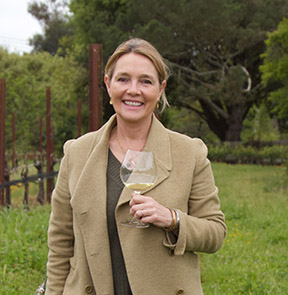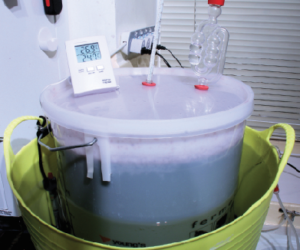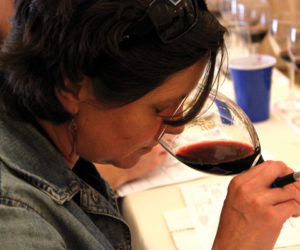The benefits of cold soaking are debated among winemakers, but those who subscribe to the technique of keeping (usually red) grapes cool for a few days prior to fermentation swear by it. Two pros share their reasons why they always cold soak, and how you can do it at home too.
Ann Moller-Racke, Blue Farm (Sonoma, California)

We produce two varietals: Pinot Noir and Chardonnay, and use cold soaking for the Pinot Noir. Cold soaking accomplishes three things:
1. Mixing – It is important to homogenize the grape mixture in the tank to get an accurate chemistry profile. One to two punch downs per day will accomplish this, since utilizing a pump would risk damaging the skins and grinding seeds.
2. Extraction – The juice is saturated with color and flavor pre-cursors before fermentation starts. However, I prefer to frontload the wine, and then be more cautious with the post-fermentation extraction in the presence of alcohol — a more powerful solvent.
3. Acidity – Perhaps the most important reason to cold soak is to observe the shift in pH over a three to four day period as potassium is released from the skins. The effect is more dramatic with whole cluster.
Prior to the cold soak we do a clean de-stemming with the berry slightly cracked, and many whole berries is the goal. Effective removal of the peduncle (cluster stem), with no shearing, prevents unwanted extraction sites. Crushing with rollers is never done.
Cold soaking at 48–50 °F (9–10 °C) is ideal. Getting the must in the tank at the right temperature is critical. Night harvest helps with this, as does dry ice. Glycol is most effective at maintaining an already correct temperature.
Depending on the health of the grapes, I’ll do a sulfite addition in the range of 0–25 ppm on the day of crush. If crushing is day 1, then I like to look at the chemistry on days two and four. Cooling will be switched off on day 4 or 5, depending on temperature. We keep an eye on the cold soak throughout. On warm days, we will have a thermometer in the bin off of the de-stemmer. If not enough dry ice is used, then spoilage can occur. If too much dry ice is added, to a T-bin for example, you end up with a grape popsicle and you have to wait for it to thaw. If you pay attention on the crush pad, then the cold soak is a straight forward process.
To sum up the most important things for home winemakers considering a cold soak:
1. Make sure the fruit is clean. Drop any suspect clusters before harvest. Sort out of the bin during picking (Botrytis, leaves, etc.). Sort again on the reception table, especially if night picked since Botrytis can be hard to spot in the dark. And finally, you can sort again coming off of the de-stemmer, especially if you are not confident in the de-stemmer’s ability to remove the peduncle.
2. Get the temperature right when you are going into the fermentation vessel. Use a thermometer. Better to be a little too cold than too warm.
3. Smell it daily. Volatile acidity (VA) — ethyl acetate, acetic acid — will let you know you are on the wrong track. If you sense problems and detect VA it is generally best to abort the cold soak. Make a 25-ppm addition of SO2 and mix it well into the must. Then pitch the yeast at 40 g/hL (or more!) with a strong strain to mathematically overwhelm the bacterial population. EC-1118 is good at scavenging all the nutrients in the must, but there are other strong choices. Isolate this lot from other fermentations.
Ben Papapietro, Papapieetro Perry (Healdsburg, California)

I think all red wines benefit from a cold soak. We make two red wines — mostly Pinot Noir, and a little Zinfandel. We always cold soak both. Pinot Noir is known for its light color, and the cold soak helps extract as much color and tannins from the skins as possible. We treat Zinfandel like the Pinot Noir. We pick it a lot sooner than most Zinfandel producers, looking for good acidity and lower Brix. The claret-style Zinfandel produced years ago before late harvest Zinfandel became famous is what we are looking for.
Most of our fruit is picked early in the morning, so the fruit arrives cold. We add SO2 at the destemmer. The amount depends on the quality of the fruit and vintage. Our standard addition is 25 ppm, but if the weather has been cool, foggy, wet, or extremely hot, we add up to 35 ppm as protection in case of some mold or rot. After, we keep our levels very low and top barrels often.
We do not include any stems in any of our cold soaks. I personally dislike the greenness stems add to Pinot Noir. I think that in Pinot Noir, acidity levels are much more important.
We usually get three days of cold soak before we see any native fermentations starting, although we wait sometimes as long as five days. It all depends on when we see the native yeast starting. We add our yeast at the start of native fermentations. We also use that cold soak time to do our testing, get results, and make any adjustments necessary in the acidity levels and Brix. We then add our yeast.
During the cold soak, we monitor each bin at least three times a day. We hand punch each bin a couple times a day until fermentation starts, then three times a day until fermentation nears completion. It’s important to check regularly both visually and by sticking your nose close to see and smell. So much can be learned just by smelling it. If something is off you can deal with it right away. If bad stuff goes on and is not observed or dealt with right away it may be impossible to correct later on.







